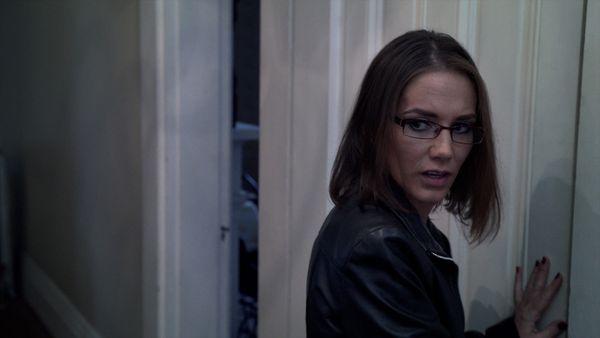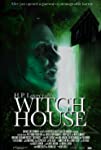Eye For Film >> Movies >> Witch House (2022) Film Review
Witch House
Reviewed by: Jennie Kermode

In early 1932, HP Lovecraft wrote a short story called The Dreams In The Witch House which was published the following year in Weird Tales. Though not amongst his most popular works, it was interesting in its development of what were then cutting edge ideas about mathematics and astrophysics, woven into the fabric of an old fashioned haunted house tale. It has previously been adapted for television by one of the author’s most notable cinematic adherents, Stuart Gordon, and it formed the basis of 1968 film Curse Of The Crimson Altar, which has the distinction of starring both Boris Karloff and Christopher Lee. This film, another loose adaptation, is unlikely to receive any serious scholarly attention, but there’s a surprising amount of craft lurking beneath its cheerfully trashy exterior.
Replacing the unhappy hero of the original, Alice Gilman (Portia Chellelynn), a student with an established fondness for Lovecraft’s work, takes an attic room in a new England guest house in order to hide out from her violent ex-boyfriend. She quickly falls in love with the odd geometry of the place and takes to chalking strange geometric symbols on the suspiciously uneven floorboards and looking up the Necronomicon online. She also spends an awful lot of time wandering around in her underwear, but at least it helps her to fit in at her new abode, as so does the landlady’s daughter. Pretty soon the two young women have found another way to spend their time. There is a bit more sauce than poor old HP could handle.

Of course, the real action here lies not in waking life but, as the title of the story promised, in dreams. It’s implied that these are the result of an enchantment, addressed here in a fairly prosaic way which only hints at Lovecraft’s ideas of a geometric and cognitive trap. The dreams themselves, however, allow director Bobby Easley to really show some skill. A lurid melange of metalwork, latex and body paint, rhythmic beats and dancing and obscure globular entities and tentacle sex, they bring together impressive low budget practical effects work with inventive camerawork. If only the editor had done as good a job with the dramatic scenes as with these, this might have been a much more successful film. There is, at any rate, plenty for genre fans to enjoy, with droplets of glowing green liquid in a nod to Re-Animator, and some classic Evil Dead style tracking shots bringing us back to the house.
Where do the dreams end? How can we tell when we’re back in reality? That’s the real question here, and one which proved narratively challenging for the author. Easley has other tools at hand and the film duly veers off into body horror territory, though it’s more about making a point than getting seriously gory. There’s been a lot of the particular theme used here in recent genre cinema, perhaps reflecting a deeper societal unease (hard to miss in the US), and frankly it feels unnecessary in this case, like the religious narrative brought in to support it, but at least it gives the story a proper conclusion.
In other regards, there isn’t as much horror here as you might expect. The original tale’s mutant rat monster, Brown Jenkin, is represented by a ridiculously cute ordinary rat in a slimmed-down role which becomes more about suggestion than subplot. His is one of the better performances, though the actors at least put some passion into their work, avoiding the flatness of many bargain bin efforts. Clearly nobody involved in making Witch House was under any illusions about the kind of film it would be. That they achieved as much as they did makes it worth of notice, at least for Lovecraft completists and fans of spirited trash.
Reviewed on: 29 Jun 2022















